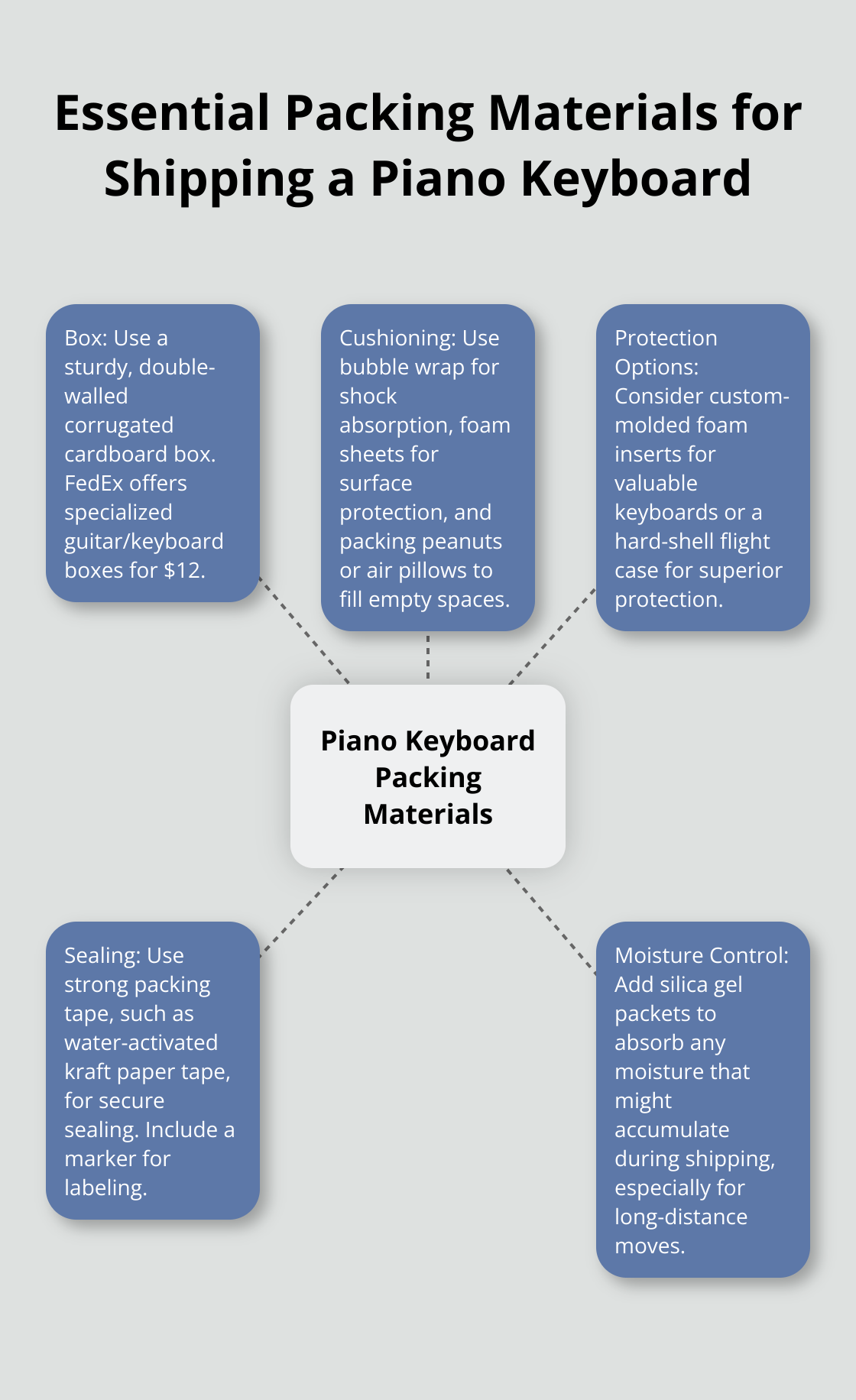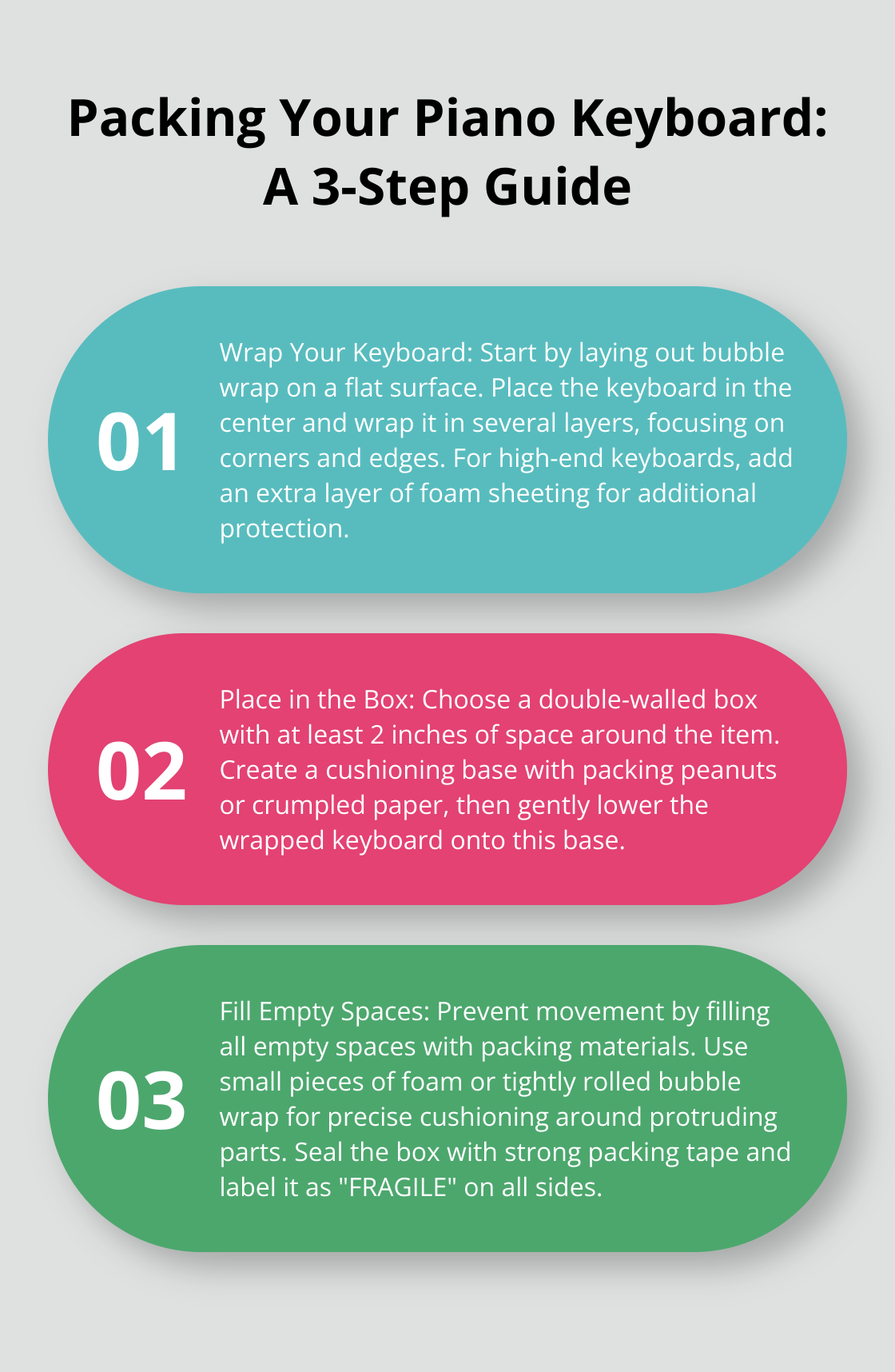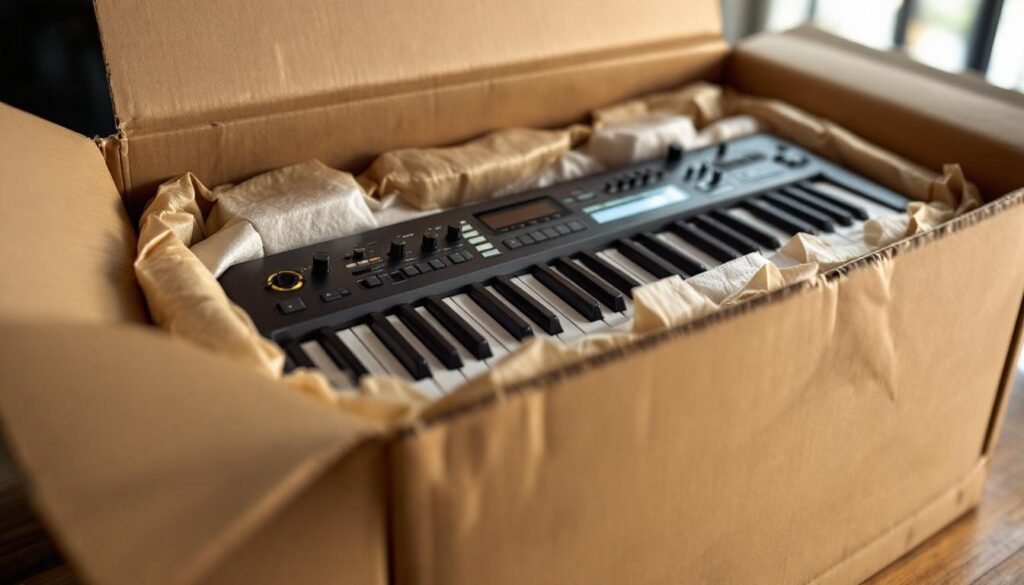Shipping a piano keyboard can be a daunting task, but with the right approach, you can ensure your instrument arrives safely at its destination. At Southbay Moving Systems, we understand the importance of protecting your valuable musical equipment during transit.
This guide will walk you through the essential steps of packing your keyboard, from selecting the proper piano keyboard shipping box to using the right materials for cushioning. By following our expert tips, you’ll minimize the risk of damage and keep your instrument in perfect condition.

How to Prepare Your Piano Keyboard for Shipping
Clean Your Keyboard Thoroughly
Start with a comprehensive cleaning of your keyboard. Use a soft, lint-free cloth to remove dust and debris from the keys, body, and control panel. For stubborn dirt, slightly dampen the cloth with water, but avoid letting moisture seep into the instrument. Focus on the crevices between keys where dust often accumulates.
Remove Batteries and Accessories
Take out all batteries from your keyboard. This step prevents potential corrosion or leakage during transit (which could severely damage your instrument). Pack the batteries separately if you plan to ship them with the keyboard.
Detach any removable parts such as power cords, sustain pedals, or music stands. Pack these items separately to prevent scratches or dents to the keyboard during shipping. If your keyboard has a cover, secure it in place to protect the keys.
Secure Internal Components
For digital pianos with weighted keys, secure the keybed. If it is on a stand, the keyboard is usually easy to separate for transport. Usually not more than 2-3 screws are needed. Check your keyboard’s manual for instructions on how to engage this feature. If your model lacks a built-in lock, consider placing a soft foam insert between the keys and the lid to prevent movement.
Protect External Controls
Tape down any knobs, sliders, or buttons that might move during transit. Use low-tack painter’s tape to avoid leaving residue on your instrument. For touch screens or delicate displays, apply a layer of plastic wrap or screen protector before taping to prevent direct contact with the adhesive.
Document the Condition
Before packing, take clear photos of your keyboard from multiple angles. If damages occur, it is essential to report them immediately, document them with photos and written descriptions, and file a claim with the shipping company.
These preparatory steps set the foundation for a safe shipping experience. The time invested in proper preparation can prevent potential heartache and costly repairs. Now that your keyboard is ready for its journey, let’s explore how to choose the right packing materials to further protect your valuable instrument.
What Packing Materials Do You Need?
Selecting the right packing materials will ensure your piano keyboard arrives safely at its destination. At Southbay Moving Systems, we’ve witnessed how proper packaging protects valuable instruments during transit.
The Perfect Box
Start with a sturdy, double-walled corrugated cardboard box. FedEx actually makes and stocks guitar/keyboard boxes for $12. Between this, bubble wrap and packing peanuts, you’re good to go.
Essential Cushioning Materials
Bubble wrap serves as your first line of defense. Choose large-bubble wrap for better shock absorption. You’ll need enough to wrap your keyboard completely, with multiple layers around corners and delicate areas.
Foam sheets provide a smooth, protective layer directly against your keyboard’s surface. Look for anti-static foam sheets if you’re shipping a digital piano to protect against electrical damage.
Packing peanuts or air pillows fill empty spaces in the box. These prevent your wrapped keyboard from shifting during transit. If using packing peanuts, opt for biodegradable options for eco-friendliness.
High-End Protection Options
For valuable or vintage keyboards, custom-molded foam inserts offer tailored protection, cradling your instrument perfectly. Use molded foam inserts in the case to prevent movement. For larger brass instruments like tubas, consider custom crating for maximum protection.
Alternatively, a hard-shell flight case designed for keyboards offers superior protection and can be reused for future moves or tours (though it comes with a higher price tag).
Additional Packing Essentials
Strong packing tape will seal your box securely. Try water-activated kraft paper tape for added strength. You’ll also need a marker for labeling the box as fragile and indicating its orientation.
Silica gel packets absorb any moisture that might accumulate during shipping (especially useful for long-distance or international moves).
Quality packing materials significantly reduce the risk of damage to your piano keyboard during shipping. The cost of proper packaging pales in comparison to the potential expense of repairing or replacing a damaged instrument.
Now that you’ve gathered all the necessary materials, let’s move on to the step-by-step process of packing your piano keyboard for safe shipping.
How to Pack Your Piano Keyboard Step by Step
At Southbay Moving Systems, we pack numerous piano keyboards. Here’s our method for safe instrument shipping.

Wrap Your Keyboard
Lay out a large sheet of bubble wrap on a flat surface. Place your keyboard in the center, keys facing up. Wrap the item in several layers of bubble wrap, covering every surface. Focus on the corners and edges (these are most vulnerable to impacts). Secure the wrap with packing tape, but don’t apply tape directly to the keyboard’s surface.
For high-end or vintage keyboards, wrap the bubble-wrapped keyboard in a layer of foam sheeting. This provides an extra buffer against shocks and vibrations during transit.
Place the Keyboard in the Box
Select a double-walled box that allows for at least 2 inches of space around the item on each side with no packing material.
Create a cushioning base before placing your wrapped keyboard in the box. Pour a layer of packing peanuts or crumpled packing paper about 2 inches deep. Lower your wrapped keyboard onto this base gently.
Fill Empty Spaces
Prevent any movement inside the box to ensure safe shipping. Fill all empty spaces with packing peanuts, air pillows, or crumpled packing paper. Be thorough – even small gaps can allow your keyboard to shift during transit.
Use small pieces of foam or tightly rolled bubble wrap for precise cushioning around knobs, buttons, or other protruding parts. This targeted approach prevents pressure on these delicate components.
Seal and Label the Box
Seal the box with strong packing tape once your keyboard is snugly packed. Apply tape to all seams, including the bottom of the box. Use the H-taping method: seal along the center seam, then seal the edge seams on both ends of the box.
Label the box as “FRAGILE” and “HANDLE WITH CARE” on all sides clearly. Add “THIS SIDE UP” arrows to ensure proper orientation during handling. Include the recipient’s phone number on the label to facilitate delivery (if shipping to a business address).
Consider adding “signature required” to your shipping service for valuable keyboards. This ensures someone will receive and inspect the package upon delivery.
Final Thoughts
Shipping a piano keyboard safely requires careful preparation and the right materials. You must clean your keyboard, remove detachable parts, and secure internal components to prevent movement. The selection of a proper piano keyboard shipping box and packing materials (such as bubble wrap, foam sheets, and packing peanuts) will protect your instrument during transit.
The packing process demands attention to detail. You should wrap your keyboard securely, place it in the box with ample cushioning, and fill all empty spaces. Proper sealing and labeling will alert handlers to the fragile nature of the contents.
Professional assistance can be the best option for valuable or vintage instruments. We at Southbay Moving Systems offer expert packing and shipping services for musical instruments (including piano keyboards). Our team uses high-quality materials and proven techniques to ensure your keyboard arrives at its destination in perfect condition.




